Economic Analysis: Elasticity, Monopoly in the Australian Market
VerifiedAdded on 2023/03/23
|12
|2660
|81
Report
AI Summary
This report provides an economic analysis of elasticity and monopoly power, focusing on examples within the Australian market. It examines the price elasticity of demand for various products, including soft drinks, tobacco, and gasoline, highlighting the factors that influence their elasticity. The report also discusses the concept of monopoly, using the Australian postal service as a case study, and analyzes the benefits and drawbacks of monopoly power, the role of the Australian Competition and Consumer Commission (ACCC) in regulating monopolies, and government responses to curb monopolistic practices. Desklib offers a platform for students to access similar solved assignments and past papers.
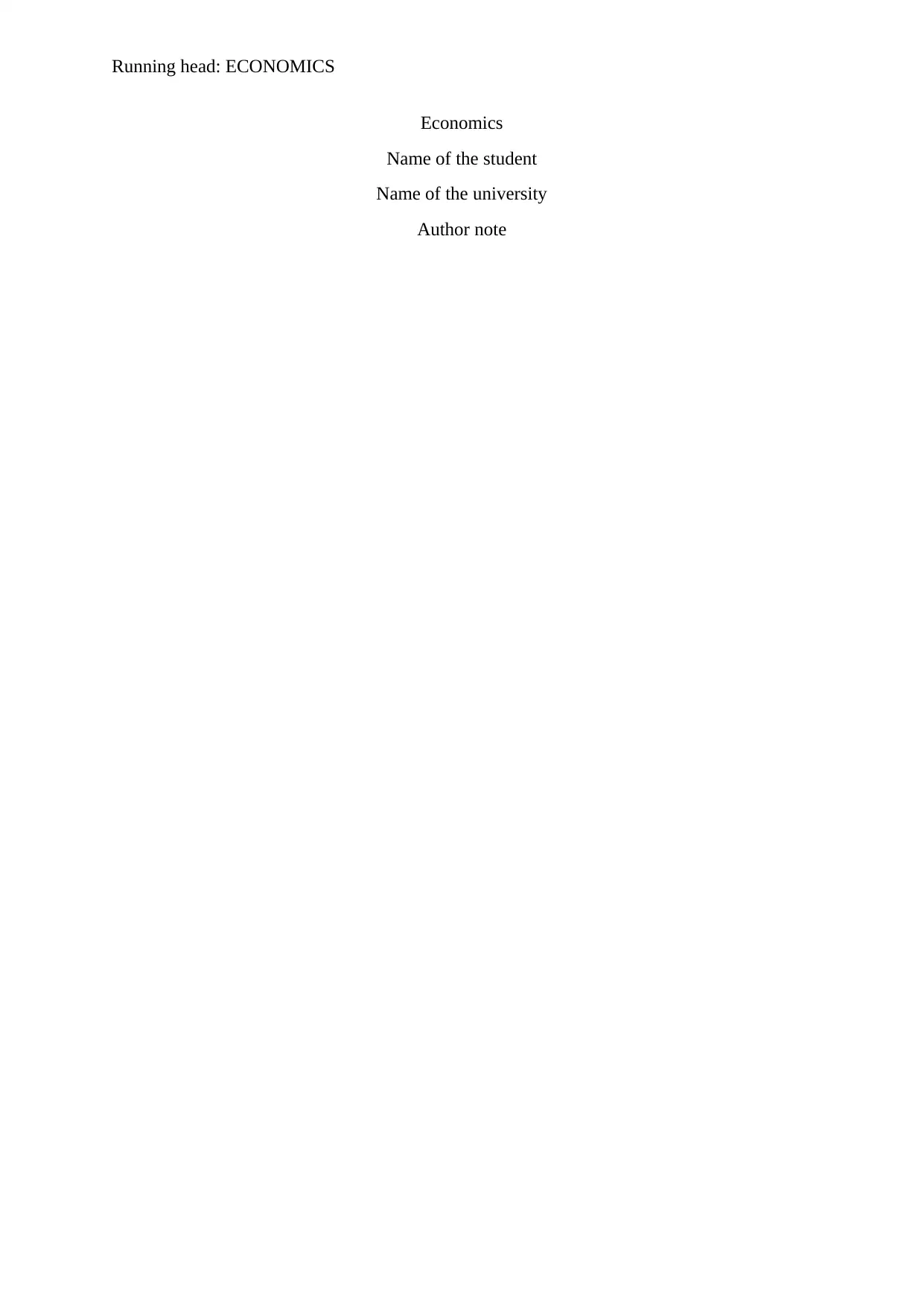
Running head: ECONOMICS
Economics
Name of the student
Name of the university
Author note
Economics
Name of the student
Name of the university
Author note
Paraphrase This Document
Need a fresh take? Get an instant paraphrase of this document with our AI Paraphraser

ECONOMICS
Answer 1
Elasticity of soft drinks
Price elasticity of the demand for soft drinks, other sugar-sweetened beverages and
energy dense food in Chile
This article states about the price elasticity of demand of the soft beverages in Chile.
The analyses the price elastic of soft drinks and have found that the own price elasticity is -
1.37. As the price elasticity is more than 1, this means the demand for soft drinks are elastic
in nature. The reason is that there is a presence of lot of substitutes of sweetened beverages.
Elastic demand takes place when price or the other factors is known to have a huge impact on
the quantity which the consumers want to buy. The elasticity of soft drinks ranges from 1.29
to 1.39. This also means that with a ten percent increase in price, the consumption will be
decreasing by 13 percent1. The demand for soft drinks are highly sensitive to the price
change. As the demand for sugar sweetened beverages are highly elastic in nature therefore
imposing tax on them for curbing the obesity. When the price of the soft drinks will rise,
people will be consuming more of water, snacks and milk. However, it has also been found
out that the decrease in the consumption of soft sweetened beverages will lead to lower
consumption of snacks as people usually consume both these two goods together.
1 Guerrero-López, C. M., Unar-Munguía, M., & Colchero, M. A. (2017). Price elasticity of the demand for soft
drinks, other sugar-sweetened beverages and energy dense food in Chile. BMC public health, 17(1), 180.
Answer 1
Elasticity of soft drinks
Price elasticity of the demand for soft drinks, other sugar-sweetened beverages and
energy dense food in Chile
This article states about the price elasticity of demand of the soft beverages in Chile.
The analyses the price elastic of soft drinks and have found that the own price elasticity is -
1.37. As the price elasticity is more than 1, this means the demand for soft drinks are elastic
in nature. The reason is that there is a presence of lot of substitutes of sweetened beverages.
Elastic demand takes place when price or the other factors is known to have a huge impact on
the quantity which the consumers want to buy. The elasticity of soft drinks ranges from 1.29
to 1.39. This also means that with a ten percent increase in price, the consumption will be
decreasing by 13 percent1. The demand for soft drinks are highly sensitive to the price
change. As the demand for sugar sweetened beverages are highly elastic in nature therefore
imposing tax on them for curbing the obesity. When the price of the soft drinks will rise,
people will be consuming more of water, snacks and milk. However, it has also been found
out that the decrease in the consumption of soft sweetened beverages will lead to lower
consumption of snacks as people usually consume both these two goods together.
1 Guerrero-López, C. M., Unar-Munguía, M., & Colchero, M. A. (2017). Price elasticity of the demand for soft
drinks, other sugar-sweetened beverages and energy dense food in Chile. BMC public health, 17(1), 180.

ECONOMICS
Figure 1 Relatively elastic demand of soft drinks
The diagram above shows the diagram of the elastic demand of the sugar sweetened
beverage. The price elasticity of demand refers to the degree of responsiveness in the quantity
demanded with the respect to price. The above diagram suggest that the buyers will be able to
easily substitute away from the soft drinks. Since overconsumption of soft drinks leads to
obesity, the health conscious people might not want that good so much, a small change in
price will be having large effect on the demand of good. Therefore, it have been observed
from the diagram that the gap between the quantities decreased is much bigger than the price
change.
Link- https://www.tobaccoinaustralia.org.au/chapter-13-taxation/13-1-price-elasticity-of-
demand-for-tobacco-produc
Price elasticity of demand for tobacco products
The price elasticity of demand states the extent at which the demand for the product
will rise or fall after the increase or decrease in price. The paper suggests that the demand for
the tobacco products is not as elastic compared to the other consumer products. The elasticity
of demand of tobacco is usually less than 1 which states that it is inelastic in nature.
According to the report published by the Word Bank a 10 percent rise in the price of tobacco
Figure 1 Relatively elastic demand of soft drinks
The diagram above shows the diagram of the elastic demand of the sugar sweetened
beverage. The price elasticity of demand refers to the degree of responsiveness in the quantity
demanded with the respect to price. The above diagram suggest that the buyers will be able to
easily substitute away from the soft drinks. Since overconsumption of soft drinks leads to
obesity, the health conscious people might not want that good so much, a small change in
price will be having large effect on the demand of good. Therefore, it have been observed
from the diagram that the gap between the quantities decreased is much bigger than the price
change.
Link- https://www.tobaccoinaustralia.org.au/chapter-13-taxation/13-1-price-elasticity-of-
demand-for-tobacco-produc
Price elasticity of demand for tobacco products
The price elasticity of demand states the extent at which the demand for the product
will rise or fall after the increase or decrease in price. The paper suggests that the demand for
the tobacco products is not as elastic compared to the other consumer products. The elasticity
of demand of tobacco is usually less than 1 which states that it is inelastic in nature.
According to the report published by the Word Bank a 10 percent rise in the price of tobacco
⊘ This is a preview!⊘
Do you want full access?
Subscribe today to unlock all pages.

Trusted by 1+ million students worldwide
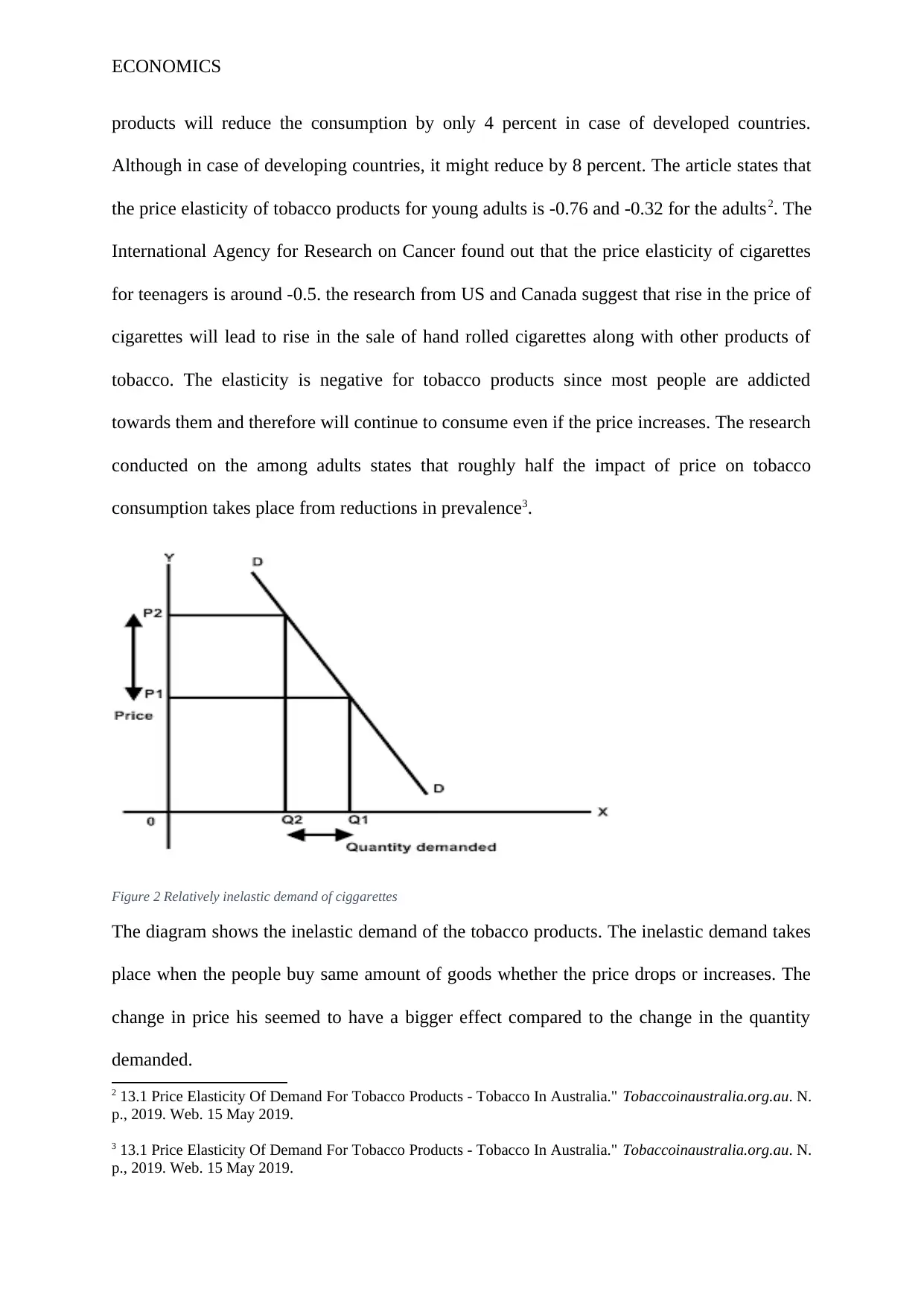
ECONOMICS
products will reduce the consumption by only 4 percent in case of developed countries.
Although in case of developing countries, it might reduce by 8 percent. The article states that
the price elasticity of tobacco products for young adults is -0.76 and -0.32 for the adults2. The
International Agency for Research on Cancer found out that the price elasticity of cigarettes
for teenagers is around -0.5. the research from US and Canada suggest that rise in the price of
cigarettes will lead to rise in the sale of hand rolled cigarettes along with other products of
tobacco. The elasticity is negative for tobacco products since most people are addicted
towards them and therefore will continue to consume even if the price increases. The research
conducted on the among adults states that roughly half the impact of price on tobacco
consumption takes place from reductions in prevalence3.
Figure 2 Relatively inelastic demand of ciggarettes
The diagram shows the inelastic demand of the tobacco products. The inelastic demand takes
place when the people buy same amount of goods whether the price drops or increases. The
change in price his seemed to have a bigger effect compared to the change in the quantity
demanded.
2 13.1 Price Elasticity Of Demand For Tobacco Products - Tobacco In Australia." Tobaccoinaustralia.org.au. N.
p., 2019. Web. 15 May 2019.
3 13.1 Price Elasticity Of Demand For Tobacco Products - Tobacco In Australia." Tobaccoinaustralia.org.au. N.
p., 2019. Web. 15 May 2019.
products will reduce the consumption by only 4 percent in case of developed countries.
Although in case of developing countries, it might reduce by 8 percent. The article states that
the price elasticity of tobacco products for young adults is -0.76 and -0.32 for the adults2. The
International Agency for Research on Cancer found out that the price elasticity of cigarettes
for teenagers is around -0.5. the research from US and Canada suggest that rise in the price of
cigarettes will lead to rise in the sale of hand rolled cigarettes along with other products of
tobacco. The elasticity is negative for tobacco products since most people are addicted
towards them and therefore will continue to consume even if the price increases. The research
conducted on the among adults states that roughly half the impact of price on tobacco
consumption takes place from reductions in prevalence3.
Figure 2 Relatively inelastic demand of ciggarettes
The diagram shows the inelastic demand of the tobacco products. The inelastic demand takes
place when the people buy same amount of goods whether the price drops or increases. The
change in price his seemed to have a bigger effect compared to the change in the quantity
demanded.
2 13.1 Price Elasticity Of Demand For Tobacco Products - Tobacco In Australia." Tobaccoinaustralia.org.au. N.
p., 2019. Web. 15 May 2019.
3 13.1 Price Elasticity Of Demand For Tobacco Products - Tobacco In Australia." Tobaccoinaustralia.org.au. N.
p., 2019. Web. 15 May 2019.
Paraphrase This Document
Need a fresh take? Get an instant paraphrase of this document with our AI Paraphraser

ECONOMICS
Link- https://www.thoughtco.com/price-elasticity-of-demand-for-gasoline-1147841
Price elasticity of gasoline
The gasoline is comparatively inelastic product which means that price changes will
be having only little impact on the demand. The price elasticity is known to measure the
responsiveness of the demand to the price changes. The article states that the average price
elasticity of the demand for gasoline is -0.26 which means that a 10 percent rise in the
gasoline price will lower the quantity demanded by only 2.6 percent4. However, in case of
long run, it have been found that the elasticity of gasoline is -0.58. As gasoline is a non
renewable good and also it does not have much substitute, the demand is mostly inelastic. In
the short run, the demand of gasoline is inelastic in nature since it will not have substitute.
With the rise in price of gasoline, the traffic volume will be going down by 1 percent within a
year and 3 percent in the long run. Therefore, it can be said that the demand for gasoline is
not very price sensitive in nature.
Figure 3 Relatively inelastic demand of gasoline
4 "What's The Price Elasticity Of Demand For Gasoline?." ThoughtCo. N. p., 2019. Web. 15 May 2019.
Link- https://www.thoughtco.com/price-elasticity-of-demand-for-gasoline-1147841
Price elasticity of gasoline
The gasoline is comparatively inelastic product which means that price changes will
be having only little impact on the demand. The price elasticity is known to measure the
responsiveness of the demand to the price changes. The article states that the average price
elasticity of the demand for gasoline is -0.26 which means that a 10 percent rise in the
gasoline price will lower the quantity demanded by only 2.6 percent4. However, in case of
long run, it have been found that the elasticity of gasoline is -0.58. As gasoline is a non
renewable good and also it does not have much substitute, the demand is mostly inelastic. In
the short run, the demand of gasoline is inelastic in nature since it will not have substitute.
With the rise in price of gasoline, the traffic volume will be going down by 1 percent within a
year and 3 percent in the long run. Therefore, it can be said that the demand for gasoline is
not very price sensitive in nature.
Figure 3 Relatively inelastic demand of gasoline
4 "What's The Price Elasticity Of Demand For Gasoline?." ThoughtCo. N. p., 2019. Web. 15 May 2019.
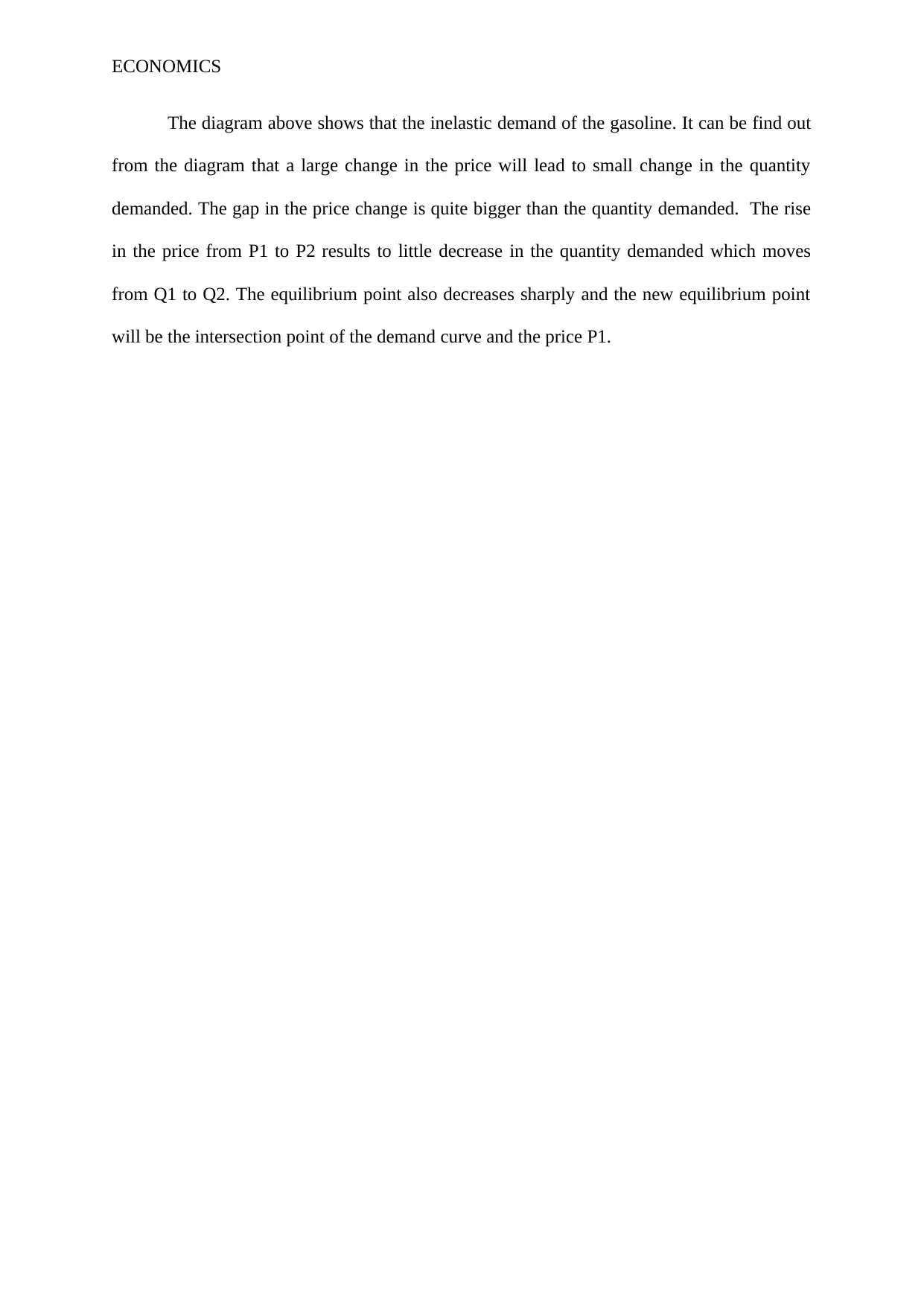
ECONOMICS
The diagram above shows that the inelastic demand of the gasoline. It can be find out
from the diagram that a large change in the price will lead to small change in the quantity
demanded. The gap in the price change is quite bigger than the quantity demanded. The rise
in the price from P1 to P2 results to little decrease in the quantity demanded which moves
from Q1 to Q2. The equilibrium point also decreases sharply and the new equilibrium point
will be the intersection point of the demand curve and the price P1.
The diagram above shows that the inelastic demand of the gasoline. It can be find out
from the diagram that a large change in the price will lead to small change in the quantity
demanded. The gap in the price change is quite bigger than the quantity demanded. The rise
in the price from P1 to P2 results to little decrease in the quantity demanded which moves
from Q1 to Q2. The equilibrium point also decreases sharply and the new equilibrium point
will be the intersection point of the demand curve and the price P1.
⊘ This is a preview!⊘
Do you want full access?
Subscribe today to unlock all pages.

Trusted by 1+ million students worldwide
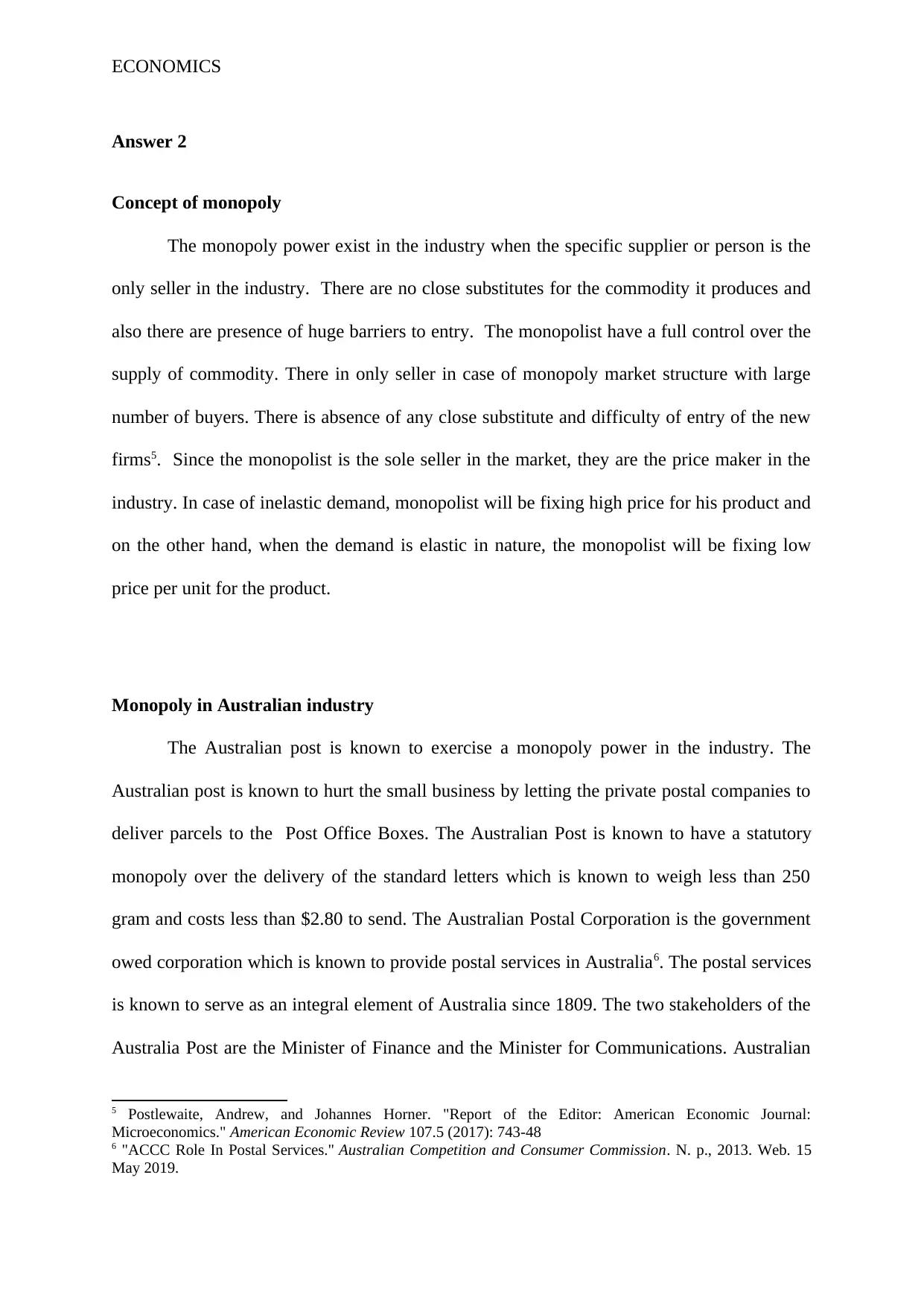
ECONOMICS
Answer 2
Concept of monopoly
The monopoly power exist in the industry when the specific supplier or person is the
only seller in the industry. There are no close substitutes for the commodity it produces and
also there are presence of huge barriers to entry. The monopolist have a full control over the
supply of commodity. There in only seller in case of monopoly market structure with large
number of buyers. There is absence of any close substitute and difficulty of entry of the new
firms5. Since the monopolist is the sole seller in the market, they are the price maker in the
industry. In case of inelastic demand, monopolist will be fixing high price for his product and
on the other hand, when the demand is elastic in nature, the monopolist will be fixing low
price per unit for the product.
Monopoly in Australian industry
The Australian post is known to exercise a monopoly power in the industry. The
Australian post is known to hurt the small business by letting the private postal companies to
deliver parcels to the Post Office Boxes. The Australian Post is known to have a statutory
monopoly over the delivery of the standard letters which is known to weigh less than 250
gram and costs less than $2.80 to send. The Australian Postal Corporation is the government
owed corporation which is known to provide postal services in Australia6. The postal services
is known to serve as an integral element of Australia since 1809. The two stakeholders of the
Australia Post are the Minister of Finance and the Minister for Communications. Australian
5 Postlewaite, Andrew, and Johannes Horner. "Report of the Editor: American Economic Journal:
Microeconomics." American Economic Review 107.5 (2017): 743-48
6 "ACCC Role In Postal Services." Australian Competition and Consumer Commission. N. p., 2013. Web. 15
May 2019.
Answer 2
Concept of monopoly
The monopoly power exist in the industry when the specific supplier or person is the
only seller in the industry. There are no close substitutes for the commodity it produces and
also there are presence of huge barriers to entry. The monopolist have a full control over the
supply of commodity. There in only seller in case of monopoly market structure with large
number of buyers. There is absence of any close substitute and difficulty of entry of the new
firms5. Since the monopolist is the sole seller in the market, they are the price maker in the
industry. In case of inelastic demand, monopolist will be fixing high price for his product and
on the other hand, when the demand is elastic in nature, the monopolist will be fixing low
price per unit for the product.
Monopoly in Australian industry
The Australian post is known to exercise a monopoly power in the industry. The
Australian post is known to hurt the small business by letting the private postal companies to
deliver parcels to the Post Office Boxes. The Australian Post is known to have a statutory
monopoly over the delivery of the standard letters which is known to weigh less than 250
gram and costs less than $2.80 to send. The Australian Postal Corporation is the government
owed corporation which is known to provide postal services in Australia6. The postal services
is known to serve as an integral element of Australia since 1809. The two stakeholders of the
Australia Post are the Minister of Finance and the Minister for Communications. Australian
5 Postlewaite, Andrew, and Johannes Horner. "Report of the Editor: American Economic Journal:
Microeconomics." American Economic Review 107.5 (2017): 743-48
6 "ACCC Role In Postal Services." Australian Competition and Consumer Commission. N. p., 2013. Web. 15
May 2019.
Paraphrase This Document
Need a fresh take? Get an instant paraphrase of this document with our AI Paraphraser

ECONOMICS
post mainly operates in three core markets which are the letter and associated services,
logistics as well as parcels and the agency service and retail merchandise which is known to
span in both the international as well as in domestic market.
Figure 4 Monopoly market structure
The Australian post will have a statutory monopoly power over the delivery of letters
which is known to weigh less than 250g that is known to cost $2.40. This particular postal
service has obligation of community service in order to supply letter service. The main
objective of the Australian Post is to carry letter within Australia as well as places outside
Australia. There is only one seller with large number of buyers which states that the
monopolist’s firm is the only firm which is also termed as the industry. Under the power of
monopoly, the monopolist have the full control over commodity supply. The Australian Post
is known to increase the price of business mail services.
In recognition to the obligations of community service, Australia post is known to
exercise a monopoly power in the carriage of letters within Australia. The services which are
covered by monopoly is termed as the “reserved services” which includes collecting and
delivering letters within Australia. The ACCC includes a number of postal regulatory
responsibilities. However the monopoly power is subject to certain number of exceptions
post mainly operates in three core markets which are the letter and associated services,
logistics as well as parcels and the agency service and retail merchandise which is known to
span in both the international as well as in domestic market.
Figure 4 Monopoly market structure
The Australian post will have a statutory monopoly power over the delivery of letters
which is known to weigh less than 250g that is known to cost $2.40. This particular postal
service has obligation of community service in order to supply letter service. The main
objective of the Australian Post is to carry letter within Australia as well as places outside
Australia. There is only one seller with large number of buyers which states that the
monopolist’s firm is the only firm which is also termed as the industry. Under the power of
monopoly, the monopolist have the full control over commodity supply. The Australian Post
is known to increase the price of business mail services.
In recognition to the obligations of community service, Australia post is known to
exercise a monopoly power in the carriage of letters within Australia. The services which are
covered by monopoly is termed as the “reserved services” which includes collecting and
delivering letters within Australia. The ACCC includes a number of postal regulatory
responsibilities. However the monopoly power is subject to certain number of exceptions
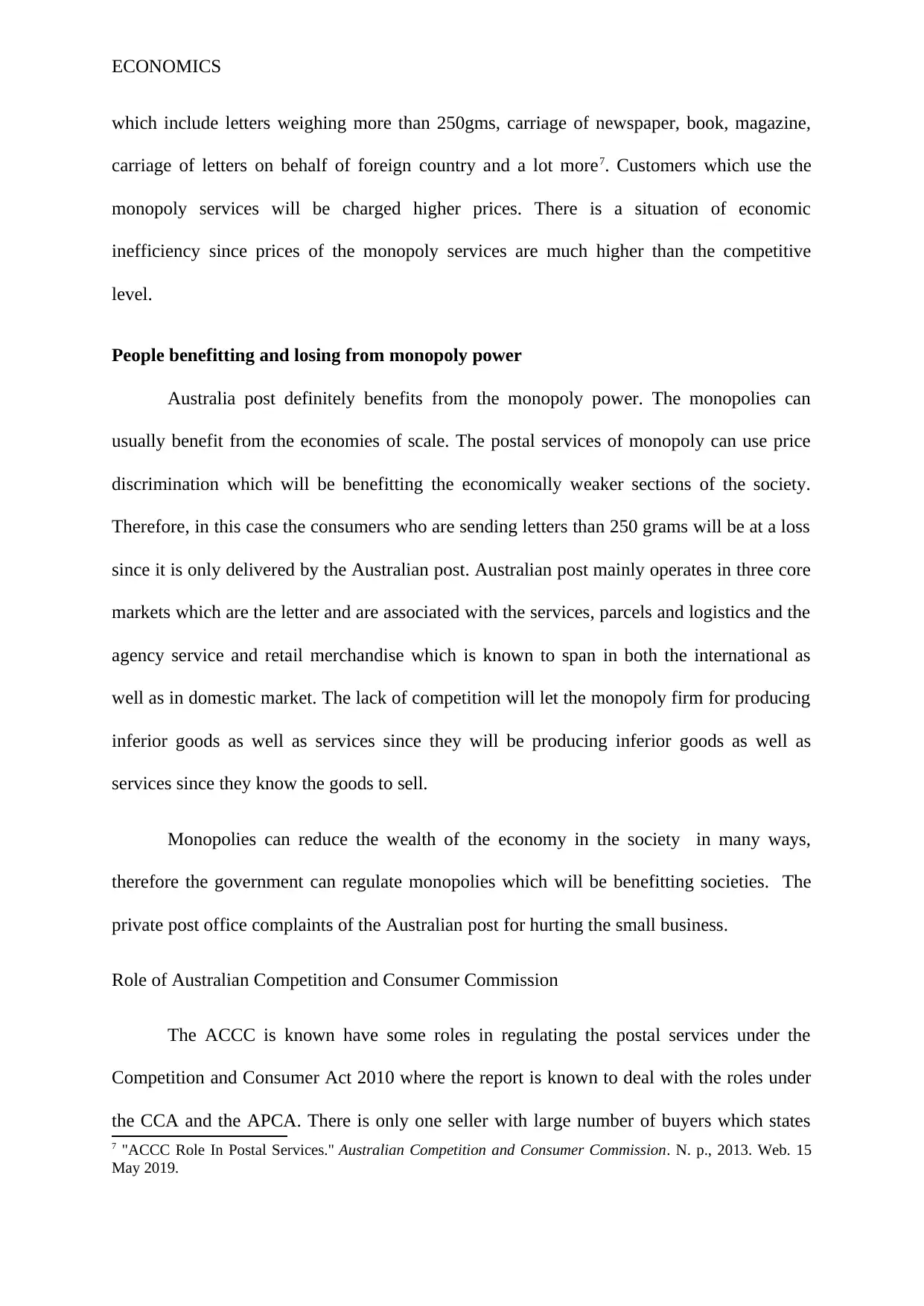
ECONOMICS
which include letters weighing more than 250gms, carriage of newspaper, book, magazine,
carriage of letters on behalf of foreign country and a lot more7. Customers which use the
monopoly services will be charged higher prices. There is a situation of economic
inefficiency since prices of the monopoly services are much higher than the competitive
level.
People benefitting and losing from monopoly power
Australia post definitely benefits from the monopoly power. The monopolies can
usually benefit from the economies of scale. The postal services of monopoly can use price
discrimination which will be benefitting the economically weaker sections of the society.
Therefore, in this case the consumers who are sending letters than 250 grams will be at a loss
since it is only delivered by the Australian post. Australian post mainly operates in three core
markets which are the letter and are associated with the services, parcels and logistics and the
agency service and retail merchandise which is known to span in both the international as
well as in domestic market. The lack of competition will let the monopoly firm for producing
inferior goods as well as services since they will be producing inferior goods as well as
services since they know the goods to sell.
Monopolies can reduce the wealth of the economy in the society in many ways,
therefore the government can regulate monopolies which will be benefitting societies. The
private post office complaints of the Australian post for hurting the small business.
Role of Australian Competition and Consumer Commission
The ACCC is known have some roles in regulating the postal services under the
Competition and Consumer Act 2010 where the report is known to deal with the roles under
the CCA and the APCA. There is only one seller with large number of buyers which states
7 "ACCC Role In Postal Services." Australian Competition and Consumer Commission. N. p., 2013. Web. 15
May 2019.
which include letters weighing more than 250gms, carriage of newspaper, book, magazine,
carriage of letters on behalf of foreign country and a lot more7. Customers which use the
monopoly services will be charged higher prices. There is a situation of economic
inefficiency since prices of the monopoly services are much higher than the competitive
level.
People benefitting and losing from monopoly power
Australia post definitely benefits from the monopoly power. The monopolies can
usually benefit from the economies of scale. The postal services of monopoly can use price
discrimination which will be benefitting the economically weaker sections of the society.
Therefore, in this case the consumers who are sending letters than 250 grams will be at a loss
since it is only delivered by the Australian post. Australian post mainly operates in three core
markets which are the letter and are associated with the services, parcels and logistics and the
agency service and retail merchandise which is known to span in both the international as
well as in domestic market. The lack of competition will let the monopoly firm for producing
inferior goods as well as services since they will be producing inferior goods as well as
services since they know the goods to sell.
Monopolies can reduce the wealth of the economy in the society in many ways,
therefore the government can regulate monopolies which will be benefitting societies. The
private post office complaints of the Australian post for hurting the small business.
Role of Australian Competition and Consumer Commission
The ACCC is known have some roles in regulating the postal services under the
Competition and Consumer Act 2010 where the report is known to deal with the roles under
the CCA and the APCA. There is only one seller with large number of buyers which states
7 "ACCC Role In Postal Services." Australian Competition and Consumer Commission. N. p., 2013. Web. 15
May 2019.
⊘ This is a preview!⊘
Do you want full access?
Subscribe today to unlock all pages.

Trusted by 1+ million students worldwide

ECONOMICS
that the firm of monopoly is the only company which is also termed as the industry8. Under
the power of monopoly, the monopolist have the total control over the commodity supply.
Government response for curbing monopoly
The government wishes for regulating the monopolies in order to protect the interest
of the consumers. The government is known for computing monopolies for preventing
excess prices and maintain the quality of the service. The government intervention will be
promoting competition in some of the industries. He also regulates the monopoly market with
taxation where the government can levy tax on per unit of output and also impose a lump sum
tax irrespective to the output. It can impose commodity tax like the sales tax and excise duty9.
He can also lower thee barriers to entry with the help of antitrust laws so that the firms can
enter the market for competing. The Australian Competition and Consumer Commission has
the power for monitoring cross subsidy in response to the complaints by the competitors of
Australia’s post that have been damaging competition by cross subsidising the contestable
services.
8 ACCC Releases Issues Paper On Price Increases Proposed By Australia Post." Australian Competition and
Consumer Commission. N. p., 2015. Web. 15 May 2019.
9 Iossa, Elisabetta, and David Martimort. "The simple microeconomics of public‐private partnerships." Journal
of Public Economic Theory 17.1 (2015): 4-48.
that the firm of monopoly is the only company which is also termed as the industry8. Under
the power of monopoly, the monopolist have the total control over the commodity supply.
Government response for curbing monopoly
The government wishes for regulating the monopolies in order to protect the interest
of the consumers. The government is known for computing monopolies for preventing
excess prices and maintain the quality of the service. The government intervention will be
promoting competition in some of the industries. He also regulates the monopoly market with
taxation where the government can levy tax on per unit of output and also impose a lump sum
tax irrespective to the output. It can impose commodity tax like the sales tax and excise duty9.
He can also lower thee barriers to entry with the help of antitrust laws so that the firms can
enter the market for competing. The Australian Competition and Consumer Commission has
the power for monitoring cross subsidy in response to the complaints by the competitors of
Australia’s post that have been damaging competition by cross subsidising the contestable
services.
8 ACCC Releases Issues Paper On Price Increases Proposed By Australia Post." Australian Competition and
Consumer Commission. N. p., 2015. Web. 15 May 2019.
9 Iossa, Elisabetta, and David Martimort. "The simple microeconomics of public‐private partnerships." Journal
of Public Economic Theory 17.1 (2015): 4-48.
Paraphrase This Document
Need a fresh take? Get an instant paraphrase of this document with our AI Paraphraser
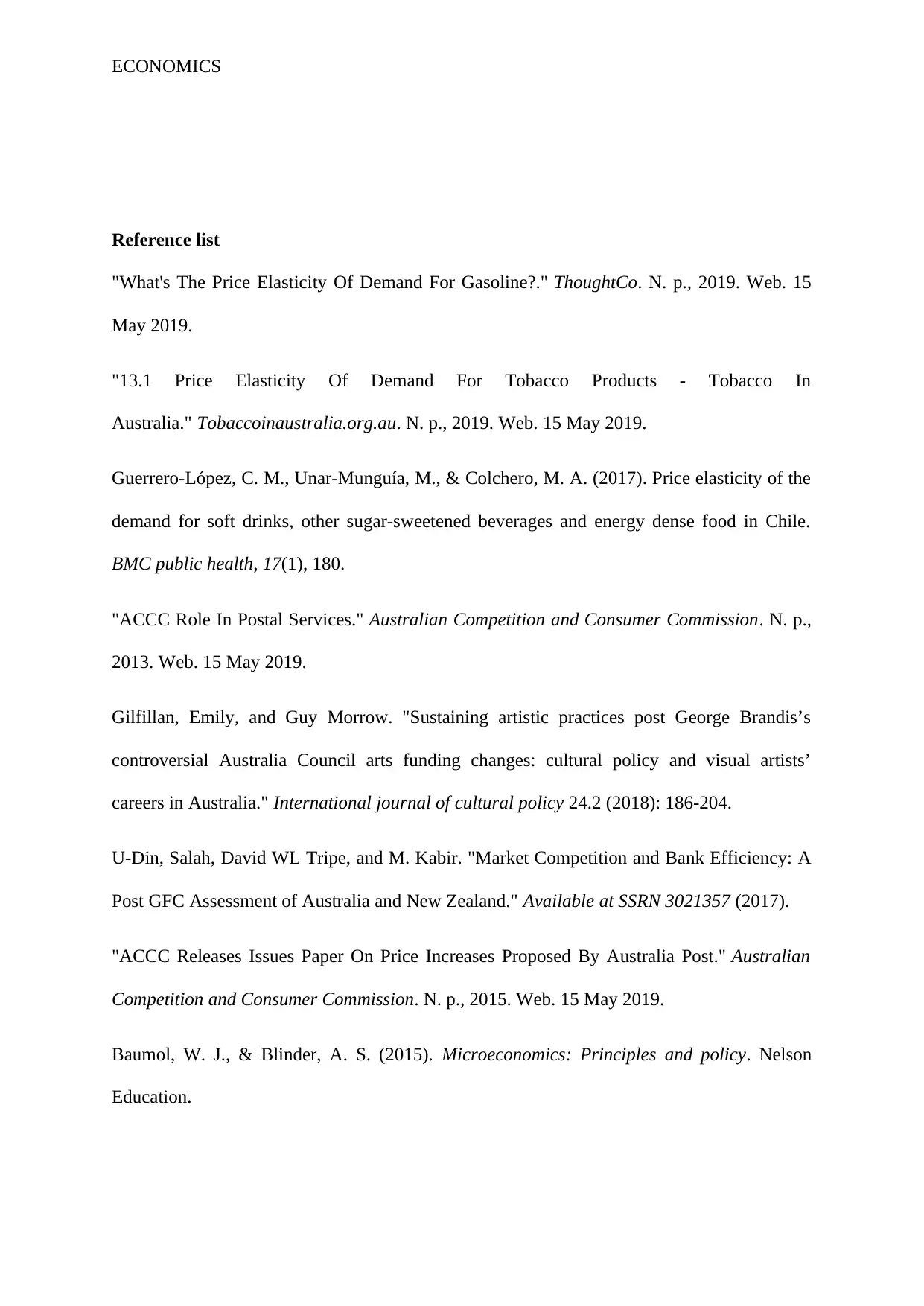
ECONOMICS
Reference list
"What's The Price Elasticity Of Demand For Gasoline?." ThoughtCo. N. p., 2019. Web. 15
May 2019.
"13.1 Price Elasticity Of Demand For Tobacco Products - Tobacco In
Australia." Tobaccoinaustralia.org.au. N. p., 2019. Web. 15 May 2019.
Guerrero-López, C. M., Unar-Munguía, M., & Colchero, M. A. (2017). Price elasticity of the
demand for soft drinks, other sugar-sweetened beverages and energy dense food in Chile.
BMC public health, 17(1), 180.
"ACCC Role In Postal Services." Australian Competition and Consumer Commission. N. p.,
2013. Web. 15 May 2019.
Gilfillan, Emily, and Guy Morrow. "Sustaining artistic practices post George Brandis’s
controversial Australia Council arts funding changes: cultural policy and visual artists’
careers in Australia." International journal of cultural policy 24.2 (2018): 186-204.
U-Din, Salah, David WL Tripe, and M. Kabir. "Market Competition and Bank Efficiency: A
Post GFC Assessment of Australia and New Zealand." Available at SSRN 3021357 (2017).
"ACCC Releases Issues Paper On Price Increases Proposed By Australia Post." Australian
Competition and Consumer Commission. N. p., 2015. Web. 15 May 2019.
Baumol, W. J., & Blinder, A. S. (2015). Microeconomics: Principles and policy. Nelson
Education.
Reference list
"What's The Price Elasticity Of Demand For Gasoline?." ThoughtCo. N. p., 2019. Web. 15
May 2019.
"13.1 Price Elasticity Of Demand For Tobacco Products - Tobacco In
Australia." Tobaccoinaustralia.org.au. N. p., 2019. Web. 15 May 2019.
Guerrero-López, C. M., Unar-Munguía, M., & Colchero, M. A. (2017). Price elasticity of the
demand for soft drinks, other sugar-sweetened beverages and energy dense food in Chile.
BMC public health, 17(1), 180.
"ACCC Role In Postal Services." Australian Competition and Consumer Commission. N. p.,
2013. Web. 15 May 2019.
Gilfillan, Emily, and Guy Morrow. "Sustaining artistic practices post George Brandis’s
controversial Australia Council arts funding changes: cultural policy and visual artists’
careers in Australia." International journal of cultural policy 24.2 (2018): 186-204.
U-Din, Salah, David WL Tripe, and M. Kabir. "Market Competition and Bank Efficiency: A
Post GFC Assessment of Australia and New Zealand." Available at SSRN 3021357 (2017).
"ACCC Releases Issues Paper On Price Increases Proposed By Australia Post." Australian
Competition and Consumer Commission. N. p., 2015. Web. 15 May 2019.
Baumol, W. J., & Blinder, A. S. (2015). Microeconomics: Principles and policy. Nelson
Education.

ECONOMICS
Iossa, Elisabetta, and David Martimort. "The simple microeconomics of public‐private
partnerships." Journal of Public Economic Theory 17.1 (2015): 4-48.
Postlewaite, Andrew, and Johannes Horner. "Report of the Editor: American Economic
Journal: Microeconomics." American Economic Review 107.5 (2017): 743-48.
Iossa, Elisabetta, and David Martimort. "The simple microeconomics of public‐private
partnerships." Journal of Public Economic Theory 17.1 (2015): 4-48.
Postlewaite, Andrew, and Johannes Horner. "Report of the Editor: American Economic
Journal: Microeconomics." American Economic Review 107.5 (2017): 743-48.
⊘ This is a preview!⊘
Do you want full access?
Subscribe today to unlock all pages.

Trusted by 1+ million students worldwide
1 out of 12
Related Documents
Your All-in-One AI-Powered Toolkit for Academic Success.
+13062052269
info@desklib.com
Available 24*7 on WhatsApp / Email
![[object Object]](/_next/static/media/star-bottom.7253800d.svg)
Unlock your academic potential
Copyright © 2020–2025 A2Z Services. All Rights Reserved. Developed and managed by ZUCOL.





